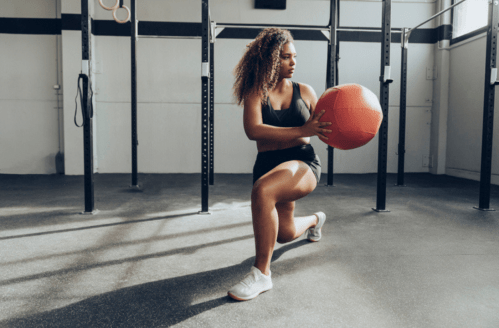If you have big boobs, the news that they can cause back pain probably isn’t surprising. It can seem like the only solution is to grin and bear it or get a breast reduction. Of course, the latter should be accessible if you want it, but if you’re looking for an alternative course of action that could help relieve some of your pain, a little strength training could help.
Experts in This Article
personal trainer, award-winning competition strongman, and sport bodybuilder
physical therapist, functional medicine health coach, and owner of Full Circle Wellness PT
Stretching and strengthening are both essential strategies for pain reduction in the body, Jessica McManus, PT, FAAOMPT, physical therapist, functional medicine health coach, owner of Full Circle Wellness PT says. The reason that large breasts can cause back pain, she explains, is because large breasts shift your center of gravity forward, which means that your back, core, shoulders, and neck muscles all have to work harder to maintain your posture. Stretching can help relieve the tension built up in clenched muscles temporarily, but strength training can help long term because stronger muscles are beneficial and can help fight against the gravitational pull, McManus says.
So what should you work on when it comes to strength training for back pain? Your first stop should be to a doctor or a physical therapist if you can. This is because you want to ensure that you don’t have any severe injuries that could be worsened by incorporating strengthening exercises in these areas. Once you’re confident that you don’t have any active injuries, the next thing to do would be to stretch. Stretching is essential for your workout to get the blood flowing and prevent injuries. Below, you’ll find some PT-approved areas to strengthen when trying to reduce boob-instigated back pain.
Your core
“The key phrase that I think of when it comes to strength training for lower back pain is midline stability which refers to the ability to stabilize the spine while squatting down, bending forward, twisting, lifting, reaching overhead, etc.,” says Dan Macera, DPT, OCS, PT at Pappas OPT Physical Sports and Hand Therapy. Strength training, when performed correctly, can be an effective way to increase midline stability through a series of progressively more intense exercises, he says. Pelvic thrusts, leg lifts, pilates, and core-focused yoga are all examples of potential core strengthening exercises to try.
Another target is the transverse abdominis, which is the deepest layer of the abdominal muscle and acts as somewhat of a corset, wrapping from the front portion of our abdomen around the back and ribs, says Dr. Macera. “We teach patients to activate this muscle by ‘drawing their belly button in towards their spine.’ Doing this while maintaining a neutral pelvic position can be very challenging,” he adds. Doing this during other exercises that engage your core—planks, pelvic thrusts (aka bridges), squats, incline sit-ups, and leg lifts—can help you develop that muscle further and support awareness on whether you’re engaging it correctly.
Your diaphragm
It may be surprising, but how you breathe can affect your back, Dr. Macera says. This is especially true if you have large breasts. The diaphragm is a large muscle that sits in your abdomen below your lungs, and it is supposed to help your breath support, he says. However, Dr. Macera says he frequently sees patients with back pain who also have shallow breathing techniques. This means that individuals inhale and exhale with the upper half of their chest without utilizing the diaphragm for deeper support. Breathing deeply can help strengthen your diaphragm and lessen the stress on your upper chest and neck muscles, which can, in turn, help reduce pain.
Your upper back
If your large breasts pull you forward, strengthening the upper back muscles (specifically the trapezius and rhomboid muscles) can positively impact posture and pain. Trying the lateral pull machine at the gym, overhead pressing weight, and side lateral dumbbell raises are great ways to strengthen the upper back, according to Hans Pirman, strongman coach and owner of Global Strongman Gym in Brooklyn, New York. You can also work these muscles via moves like the superman or dolphin kicks which are the opposite of leg lifts.
Ultimately, it’s super frustrating to have chronic pain. It’s doubly frustrating when a tool like a high-impact sports bra is hard to find and often expensive. McManus recommends that you pay attention to other details in your life, like your desk set up or walking posture. Take it easy on yourself and approach strength training slowly for the best, safest results.
Oh hi! You look like someone who loves free workouts, discounts for cutting-edge wellness brands, and exclusive Well+Good content. Sign up for Well+, our online community of wellness insiders, and unlock your rewards instantly.
Sign Up for Our Daily Newsletter
Get all the latest in wellness, trends, food, fitness, beauty, and more delivered right to your inbox.
Got it, you've been added to our email list.











